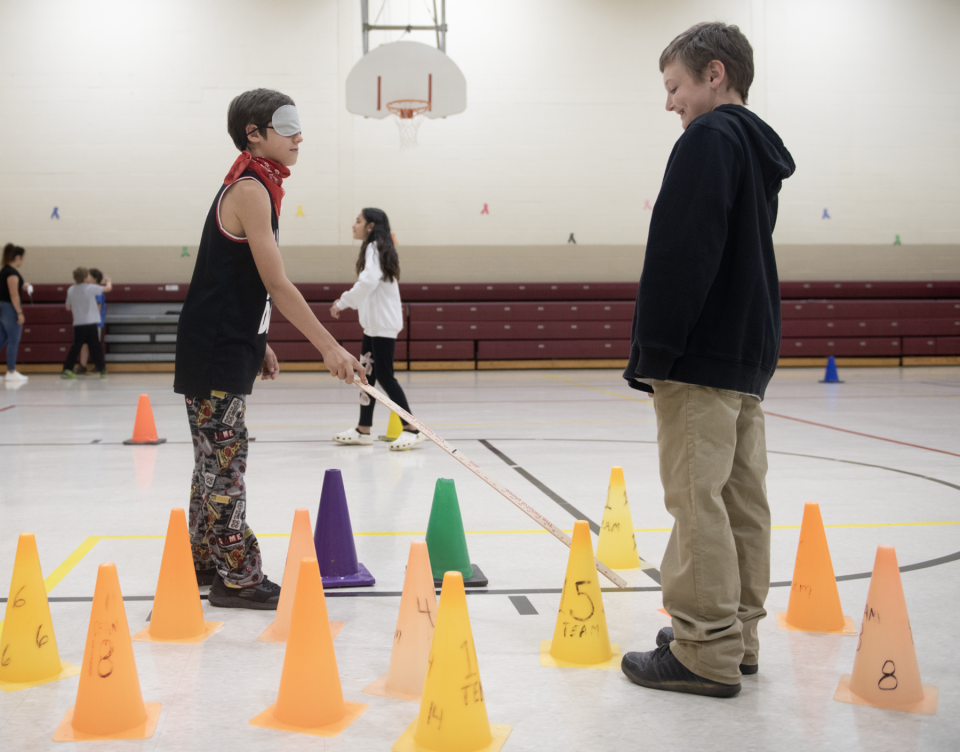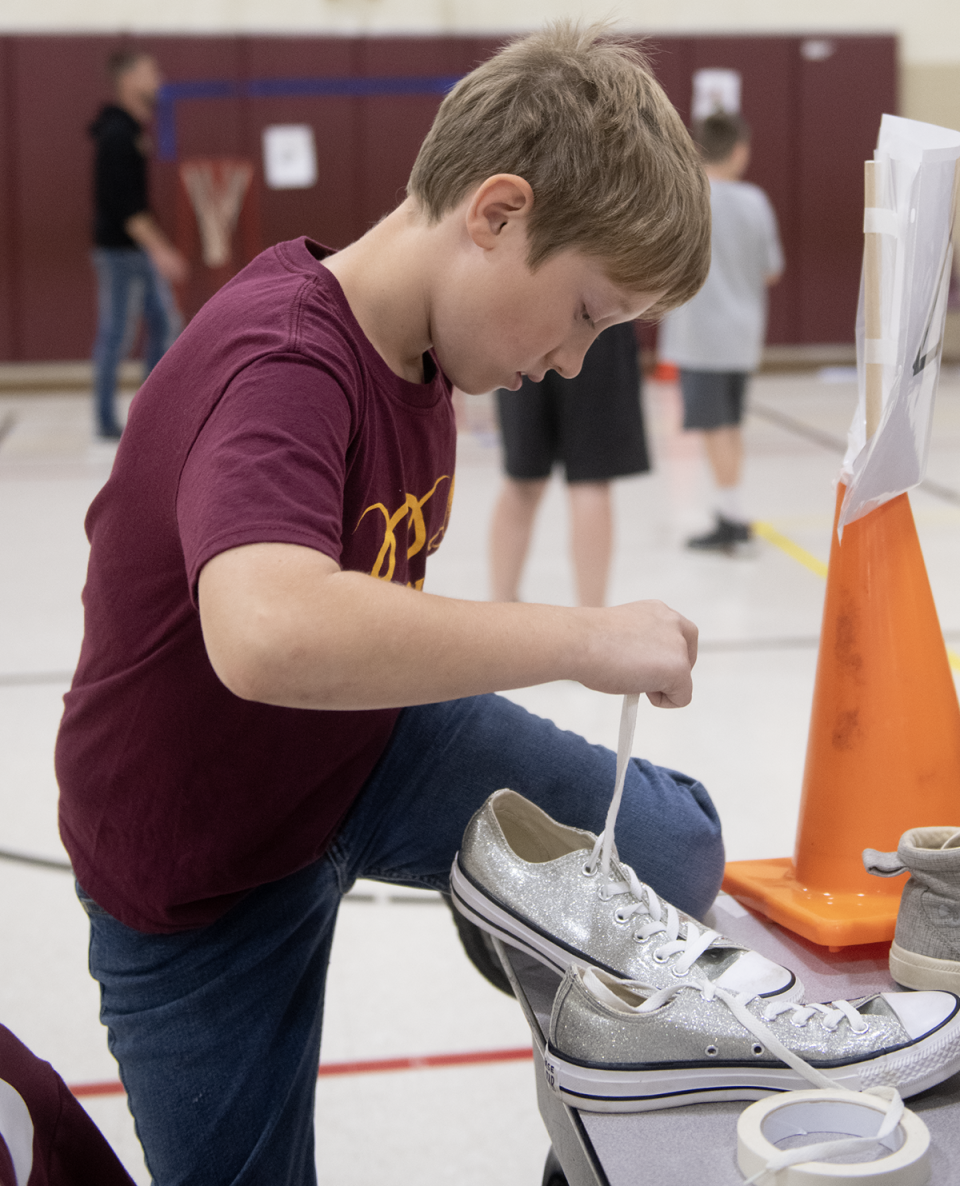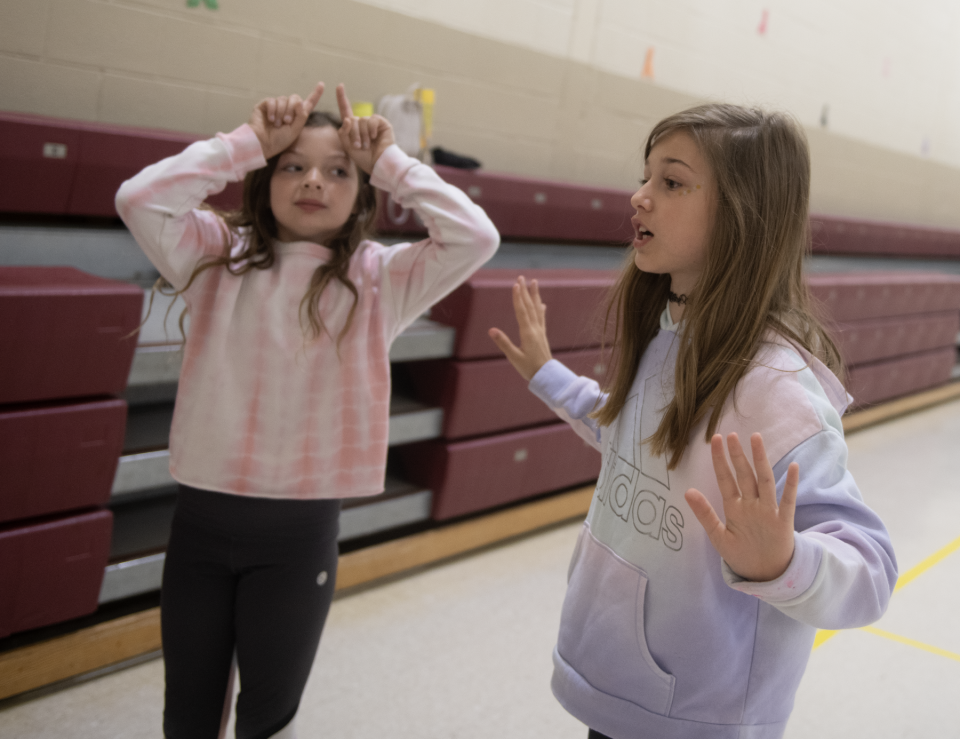Southeast schools Abilities Week teaches students about the challenges many face
A girl was wearing a blindfold as she used a yellow yard stick to guide her way through a cluster of small traffic cones while a boy held her arm to help her.
Another boy, also wearing a blindfold and holding a similar yard stick, walked beside her before he unknowingly walked past the last cone, getting roughly another 10 feet before a woman volunteer running and laughing behind was able to catch up and stop him.
In another part of the Southeast Intermediate School gymnasium, other fourth graders were zigzagging in wheelchairs or with walkers along more cones placed in a straight line. In the center of the room, students attempted to tie shoe laces on a table with one hand and pick up balls and other objects with one hand while wearing a sock and tape wrapped around their fingers.
"I think that we all needed to learn this because some people are really rude to people with disabilities, so I think some people should really care more about other people," said fourth grader Kaylee Hunt.
Kaylee was among Southeast Intermediate and Primary school students taking part in Abilities Week, which started Monday.
Michelle Rentsch, the Southeast school district's director of special services, said in an email that it is "a week emphasizing all abilities, inclusion and empathy for all students."
"Abilities Week is a celebration of the many great abilities our students have," Rentsch said.
During the week, students in the schools learned about autism, visual and hearing impairments, and Down syndrome in their classrooms, as well as during gym, art, technology, library and music time.
"Time was given each day for students to ask any questions they may have," Rentsch said. "We encouraged the families to also have conversations at home to promote acceptance and understanding for all students."

In a written statement, Southeast Superintendent Robert Dunn praised the effort.
"The Southeast Abilities Week has been an incredible opportunity for our students and staff to experience many different perspectives and challenges that some of our students experience on a daily basis," said Dunn. The hands-on activities have been powerful and engaging. These learning experiences will benefit all of our students and stick with them for years to come."
A week of activities
Abilities Week was spearheaded by Christina Hemberger, who, as a parent mentor, guides families through the special education process in the Southeast and Field schools.
It is a personal matter for Hemberger. Two of her children with husband, Todd, one of a number of volunteers helping with Abilities Week, have attention deficit/hyperactivity disorder. And their son Paxton, a Southeast Intermediate student, is nonverbal and uses a wheelchair due to cerebral palsy.
"The students at Southeast have always been so caring and supportive of my son but always have a lot of questions," she said. "So after some reflection, I remembered doing something like Abilities Week back in the '90s and the experience I had then had always stuck with me. So I thought this would be a great opportunity to do something like this at Southeast to help the students understand multiple different types of disabilities they may see throughout their school and their community."
The activities in the gym on Thursday were part of that effort.
Students were learning what it feels like to have to guide themselves around obstacles without being able to see or while maneuvering a wheelchair or a walker. They also simulated the struggles of tying a shoe with only one hand or picking up objects with reduced fine motor skills in their hand.

"The kids have been so engaged today," said Hemberger. "They've been trying. It's been great."
In one corner, students played charades to see what it is like to have to communicate without speaking. At the gym's opposite end, they threw basketballs at a hoop while blindfolded or using their non-dominant hand.

At a table on one side of the gym, parent volunteer Alishia Ritchie showed students a tablet that some non-verbal people use to communicate by pressing buttons on a screen.
Also on the table were sheets of paper with symbols on them, which students took turns touching while others tried to figure out what they were trying to say.
Ritchie told the students that if they encounter someone who is nonverbal, they should be "open minded."
"Just because they can't vocalize, doesn't mean they don't have feelings," she said.
In art class, students drew pictures with their non-dominant hand and were shown adaptive art equipment in art class.
In the library, they navigated the space in wheelchairs and walkers and watched educational videos, with a wheelchair and walker;.
And during music class, learned a song in sign language and heard about famous musicians with disabilities.
Teachers also were encouraged to read books or show videos related to disabilities in their homerooms.
Kaylee and classmate Benjamin O'Neill said Abilities Week taught some valuable lessons that everyone should take to heart.
"I learned that a lot of people with disabilities have a harder life than people with no disabilities, so you have to learn about it a lot so you don't make fun of them," Benjamin said.
The week culminated with school staff scheduled to play wheelchair basketball against a team from nonprofit Adaptive Sports Ohio on Friday.
A lot of support
Hemberger said Abilities Week got a lot of support from teachers and school staff, as well as volunteers — including parents, Southeast High School students and from the Portage County Board of Developmental Disabilities — and from the wider community.
Various donations were provided by Gioninos Pizzeria in Edinburg, Pizza Hut and Dunkin' Donuts in Ravenna, and Sam's Pizza and Sub Stop in Newton Falls. Miller's Rental and Sales provided the wheelchairs. The DD Board and Ravenna-based Buckeye Residential Solutions also provided donations supporting the effort.
Nationwide nonprofit Pet Partners brought therapy dogs in during the week for students to meet and learn about.
Hemberger said she hopes Abilities Week becomes an annual event. She wants it to be positive, focusing more on what people with disabilities can do than on what they can not.
"I wanted to make sure we had the emphasis on abilities more than the disability," said Hemberger. "A lot of students have so many questions about various disabilities and noticed my son and I wanted to give them that safe space to ask questions and just to feel more comfortable being around others that may have a disability. I also wanted to help encourage empathy, kindness and respect that people with disabilities are still human and have feelings just like everyone else, so we need to always remember to be kind because you never know what someone is going through."
Reporter Jeff Saunders can be reached at jsaunders@recordpub.com.
This article originally appeared on Record-Courier: Southeast schools Abilities Week teaches students about challenges

